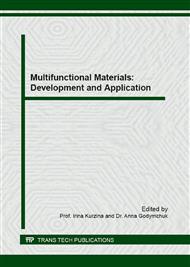[1]
Е.F. Belenky, I.V. Riskin, Chemistry and Technology of Pigments. Edition 4. Chemistry, St. Petersburg, (in Russian), (1974).
Google Scholar
[2]
A.R.M. Cornell, U. Schwertmann, The Iron Oxides: Structure, Properties, Reactions, Occurrences and Uses. Wiley-VCH Verlag GmbH and Co. KgaA, (2003).
Google Scholar
[3]
J. Drbohlavova, R. Hrdy, V. Adam, R. Kizek, О. Schneeweiss, J. Hubalek, Preparation and properties of various magnetic nanoparticles. Sensors. 9/4 (2009) 2352-2362.
DOI: 10.3390/s90402352
Google Scholar
[4]
S. Laurent, D. Forge, M. Port, A. Roch, C. Robic, E. L. Vander, R.N. Muller, Magnetic iron oxide nanoparticles: synthesis, stabilization, vectorization, physicochemical characterizations and biological applications. Chem. Rev. 108/6 (2008).
DOI: 10.1021/cr068445e
Google Scholar
[5]
B.С. Catherine, A.S.G. Curtis, Functionalisation of magnetic nanoparticles for applications in biomedicine. J. Phys. D: Applied Physics. 36/13 (2003) 198-206.
Google Scholar
[6]
О.D. Lukashevich, N.Т. Usova, V.А. Kutugin, V.А. Lotov, The use of secondary products of water treatment in the production of iron oxide for building materials. Water: Technology and ecology. Problems and Solutions (in Russian). 2 (2011) 30-38.
Google Scholar
[7]
L.F. Ikonnikova, K.V. Ikonnikova, E.A. Koltunova, Energy and resource saving raw materials for dactyloscopy. MATEC Web of Conferences 19 (2014).
DOI: 10.1051/matecconf/20141901017
Google Scholar
[8]
Yu.G. Frolov, The Course of Colloid Сhemistry. Surface Effects and Disperse systems. LC TND Al'yans Publlishing, Moscow (in Russian), (2004).
Google Scholar
[9]
T Kobayashi, Pigment dispersion in water-reducible paints. Progress in Organic Coatings, 28/2 (1996) 79-87.
DOI: 10.1016/0300-9440(95)00608-7
Google Scholar
[10]
S. Lefebure, E. Dubois, V. Cabuil, S. Neveu, R. Massart, Monodisperse magnetic nanoparticles: preparation and dispersion in water and oils. J. Mater. Res. 13/10 (1998) 2975-2981.
DOI: 10.1557/jmr.1998.0407
Google Scholar
[11]
K.M. Lee, M.S. Corensen, J.K. Klabunde, G.C. Hadjipanayis, synthesis and characterization of stable colloidal Fe3O4 particles in W/O microemulsions. IEEE Transactions on Magnetics, 28/5 (1992) 3180-3182.
DOI: 10.1109/20.179751
Google Scholar
[12]
S.A. Jadhav, R. Bongiovanni, D.L. Marchisio, D. Fontana, C. Egger, Surface modification of iron oxide (Fe2O3) pigment particles with amino-functional polysiloxane for improved dispersion stability and hydrophobicity. Pigment and Resin Technol., 43/4 (2014).
DOI: 10.1108/prt-07-2013-0057
Google Scholar
[13]
G.D. Ransinchung, B. Kumar, V. Kumar, Assessment of water absorption and chloride ion penetration of pavement quality concrete admixed with wollastonite and microsilica. Const. and Building Mater., 23/2 (2009) 1168-1177.
DOI: 10.1016/j.conbuildmat.2008.06.011
Google Scholar
[14]
L. Cao, T.P. Price, M. Weiss, D. Gao, Super water- and oil-repellent surfaces on intrinsically hydrophilic and oleophilic porous silicon films. Langmuir, 24/5 (2008). 1640-1643.
DOI: 10.1021/la703401f
Google Scholar
[15]
M. Grundner, H. Jacob, Investigations on hydrophilic and hydrophobic silicon (100) wafer surfaces by X-ray photoelectron and high-resolution electron energy loss-spectroscopy. Applied Physics A Solids and Surfaces, 39/2 (1986) 73-82.
DOI: 10.1007/bf00616822
Google Scholar
[16]
K.V. Ikonnikova, L.F. Ikonnikova, T.S. Minakova, Yu.S. Sarkisov, The theory and practice of pH metric definition of acid-base properties of the solid body surface, Tomsk: Publishing House of Tomsk Polytechnic University (in Russian), 2011. Access mode: http: /elibrary. ru/item. asp?id=22974277.
Google Scholar
[17]
R.G. Beits, Determination of pH. Theory and Practice. Chemistry, St. Petersburg (in Russian), (1972).
Google Scholar
[18]
S.A. Kuznetsova, L.F. Ikonnikova, V.V. Kozik, Gas-sensing properties of antimony-doped SnO2. Inorg. Mater., 43/6 (2007) 622-626.
DOI: 10.1134/s002016850706012x
Google Scholar
[19]
A.A. Zhigal'skii, L.F. Ikonnikova, T.S. Minakova, V.A. Mukhachev, P.E. Troyan, Temperature dependence of the dielectric strength of zinc sulfide films. Rus. Phys. J., 39/6 (1996) 576-578.
DOI: 10.1007/bf02437024
Google Scholar
[20]
S. Morrison, Chemical Physics of Solid Surfaces. Mir, Moscow (in Russian), (1980).
Google Scholar
[21]
G. Parfit, K. Rochester, Adsorption From Solutions on Solid Surfaces. Mir, Moscow (in Russian), (1986).
Google Scholar
[22]
М. Jarlbring, L. Gunneriusson, B. Hussmann, W. Forsling, Surface complex characteristics of synthetic maghemite and hematite in aqueous suspensions. J. Colloid Interface Sci., 285/1 (2005).
DOI: 10.1016/j.jcis.2004.11.005
Google Scholar
[23]
C.K. Sia, Mohd, S. Hakimi, P. Ong, K.J. Fie, Iron oxide rust as raw material for the production of red pigment in paint industry. Appl. Mechanics and Mater., 660 (2014) 229-233.
DOI: 10.4028/www.scientific.net/amm.660.229
Google Scholar
[24]
T. Hiemstra, W.H. Van Riemsdijk, Adsorption and surface oxidation of Fe(II) on metal (hydr) oxides. Geochim. Cosmochim. Acta, 71/24 (2007) 5913-5933.
DOI: 10.1016/j.gca.2007.09.030
Google Scholar
[25]
W. Wu, Q. He, C. Jiang, Magnetic iron oxide nanoparticles: Synthesis and surface functionalization strategies. Nanoscale Res. Let. 3/11 (2008) 397-415.
DOI: 10.1007/s11671-008-9174-9
Google Scholar
[26]
Z.P. Chen, Y. Zhang, S. Zhang, J.G. Xia, J.W. Liu, K. Xu & N. Gu, Preparation and characterization of water-soluble monodisperse magnetic iron oxide anoparticles via surface double-exchange with DMSA. Colloids Surf. A, 316/1-3 (2008) 210-216.
DOI: 10.1016/j.colsurfa.2007.09.017
Google Scholar
[27]
T.V. Kuznetsova, I.V. Kudryashov, V.V. Timashev. Physical Chemistry of Binding Materials: Study Quide for Chemistry-technological Specialties of Institutes of Higher Education. Higher school, Moscow (in Russian), (1989).
Google Scholar


